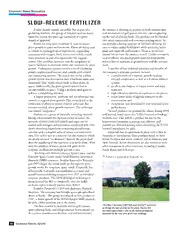
NASA Technical Reports Server (NTRS) 20020064968: Slow-Release Fertilizer PDF
Preview NASA Technical Reports Server (NTRS) 20020064968: Slow-Release Fertilizer
Consumer/Home/Recreation SLOW-RELEASE FERTILIZER Zeolite already sounds unearthly. But as part of a the mixture is showing its prowess in both construction gardening fertilizer, this group of minerals with an exotic and renovations of golf greens and tees, and toughening name has earned the space age equivalent of a green up the turf of playing fields. The product can be blended thumb of approval. into other commercial and consumer potting mixes. Its NASA has long been interested in ways to sustain use provides a lasting reservoir of nutrients allowing the plant growth in space environments. Plants are being eyed user to reduce added fertilization while achieving better as critical to prolonged space exploration, supporting plant and vegetable performance. There is an environ- astronauts with oxygen, food, water, and to help recycle mental bonus from the product as well. Unlike commonly waste products as part of a regenerative life support used fertilizers, the plant-growth material dramatically system. One problem, however, was the complexity of reduces loss of nutrients to groundwater and the environ- system hardware to maintain water and nutrients for plant ment. growth. Hydroponic systems involve a set of circulating A number of key technical advances and benefits of pumps, sophisticated sensors, and complicated control the company’s zeoponic products include: and monitoring systems. The search was on for a plant • a combination of a superior growth medium growth system that minimized such a hardware maze and and soil conditioner, as well as a fertilizer delivery eliminated “free” water which tends to float about in system; space. Additionally, the plant growth system had to • an all-in-one balance of major, minor and trace operate reliably in space. Using a medium analogous to nutrients; soil was a simplifying solution. • high-efficiency delivery of nutrients to the plants; A highly productive, synthetic soil (or substrate) was • much lower losses of applied nutrients to the created to support plant growth. This research led to the environment; and cultivation of plants in zeolite mineral substrates that • exceptional root development and improved plant contain essential, plant growth nutrients. The technique performance. was termed “zeoponics.” “Several products are planned for release during 1998 Zeolites are a group of naturally occurring minerals and beyond, based upon this NASA-licensed technology,” having a honeycomb-like layered crystal structure. Its Andrews says. One will be a product for use by the network of interconnected tunnels and cages can be homeowner/consumer, a potting mix additive, and loaded with nitrogen and potassium, combined with other possible pre-blended potting mixes containing the NASA- slowly dissolving ingredients containing phosphorous, licensed ingredients, he adds. calcium, and a complete suite of minor and trace nutri- ZeoponiX has an agreement in place with a firm in ents. The zeolite acts as a reservoir for the nutrients which Australia to manufacture these products based on slow- are slowly released “on demand.” Indeed, the plant itself release fertilizer and active synthetic soil in Australia and does the regulating of the nutrients as it needs them. With New Zealand. Active discussions are also underway with only the addition of water, plants will grow in the other companies in other countries, including Canada, zeoponic medium for multiple growth cycles. South Korea and in Europe. Working with NASA’s Johnson Space Center and the Kennedy Space Center under Small Business Innovation TM ZeoPro is a trademark of ZeoponiX, Inc.. Research (SBIR) contracts, Boulder Innovative Technolo- gies (BIT) began the initial work on the superior plant growth media for long-term space travel. ZeoponiX, Inc. of Louisville, Colorado was established as a sister and spinoff commercializing company from BIT to introduce zeoponic products. The SBIR-developed technology is being licensed by BIT to ZeoponiX, who also holds exclusive rights to issued patents from NASA. Explains ZeoponiX’s CEO and chairman, Richard Andrews, “the company has brought space age agriculture down to Earth.” The group introduced its first product in 1997, a direct spinoff of the NASA-funded SBIR research, he adds. Other products are in the works. The Ohio Clearview Golf Club used ZeoProTM nutrients The first creation is currently sold to golf courses, to change the type of grass on the green. Success has sports playing fields, and for greenhouse horticultural use. exceeded expectations—due to the release of zeoponic As a proven combination fertilizer and soil amendment, materials in the root zone of the new seedlings. 68 Commercial Benefits—Spinoffs
